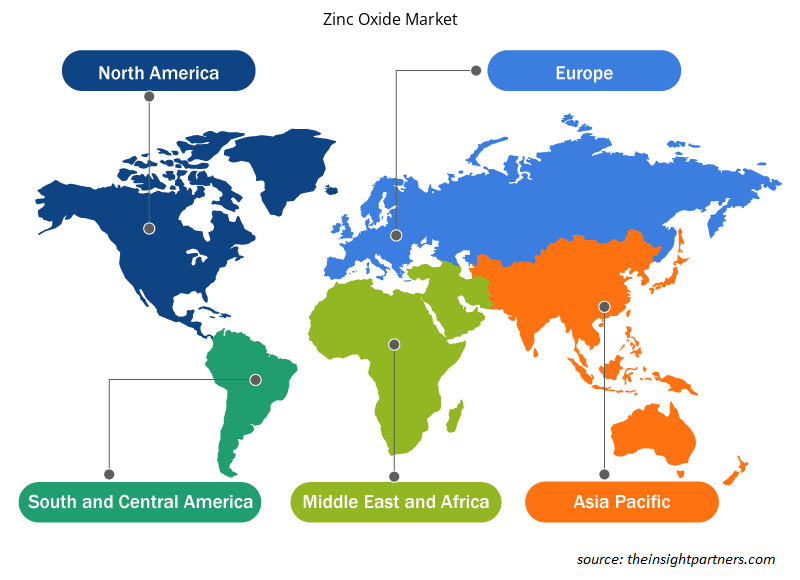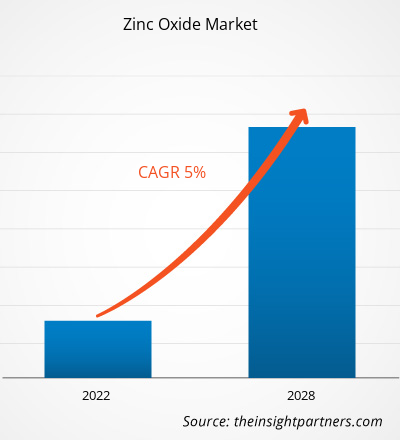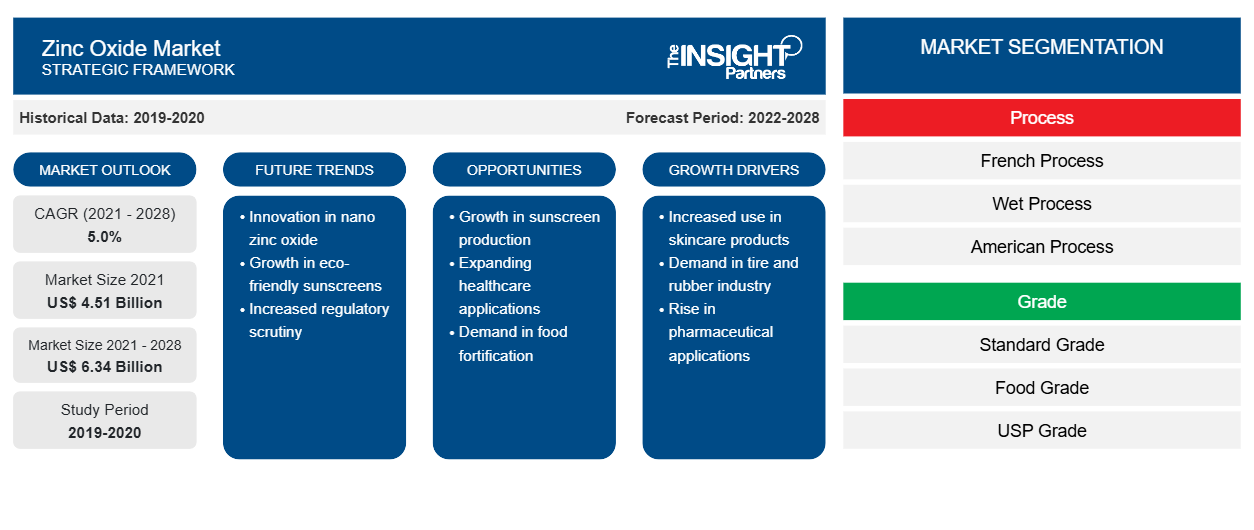2021 年氧化锌市场规模价值 45.0651 亿美元,预计到 2028 年将达到 63.3882 亿美元;预计 2021 年至 2028 年的复合年增长率为 5.0%。
氧化锌是一种无机化合物,分子式为 ZnO。它是一种不溶于水的白色粉末,被广泛用作多种材料和产品的添加剂。此外,ZnO 还用于橡胶的硫化以提高其耐久性。轮胎行业还将这种硫化橡胶用于轮胎制造。由于轮胎产量不断增长,橡胶行业消耗了全球一半以上的 ZnO。此外,智能设备产量的增加以及化妆品和个人护理产品(包括化妆品、婴儿润肤露、爽身粉和沐浴皂)中氧化锌的使用量增加是氧化锌市场的主要驱动力。它还用作非处方药产品(如防晒霜)的填充剂、着色剂和皮肤保护剂。
此外,氧化锌被广泛用作汽车发动机润滑油的添加剂,以减少氧化腐蚀和磨损。氧化锌用于制造各种类型的润滑剂,例如极压润滑剂、抗卡死润滑剂和润滑脂。因此,上述产品需求量很大,相关行业正在呈正增长。例如,根据 Statista 的研究,2021 年,全球化妆品行业的收入约为 810 亿美元,与上一年相比增长了约 8%。同样,根据 Statista 的报告,2021 年,汽车润滑油的收入为 702 亿美元,与 2020 年相比增长了约 5%。因此,氧化锌的广泛应用正在提高其消费率,从而推动市场增长。
定制此报告以满足您的需求
您可以免费定制任何报告,包括本报告的部分内容、国家级分析、Excel 数据包,以及为初创企业和大学提供优惠和折扣
- 获取此报告的关键市场趋势。这个免费样品将包括数据分析,从市场趋势到估计和预测。
COVID-19 疫情对氧化锌市场的影响
COVID-19 疫情对全球各行业的增长造成了重大干扰。同样,COVID-19 疫情在 2020 年对氧化锌市场产生了重大影响,当时由于货物运输受限,氧化锌原材料的供应链受到阻碍。多个国家放松封锁规范,制药行业不断发展,全球对氧化锌的需求持续增长。除此之外,快速的 COVID-19 疫苗接种计划和全球药品中氧化锌采用率的提高促进了氧化锌市场的增长,氧化锌制造商的业务也出现了显着增长。
市场洞察
农业对绿色氧化锌纳米颗粒的需求不断增长
随着全球对无化学食品的需求不断增长,绿色氧化锌纳米颗粒的消费量也在增加,因为它是传统化学方法的安全替代品,不会留下任何空气污染物。氧化锌纳米颗粒对发芽有效,可改善植物的发育。它还有助于提高茎和根的生长速度,而不会提取土壤养分。由于绿色氧化锌纳米颗粒具有土壤恢复特性并可提高作物产量,因此对绿色氧化锌纳米颗粒的需求逐渐增加。
流程洞察
根据工艺,全球氧化锌市场分为法式工艺、湿法工艺、美式工艺和其他工艺。2020 年,法式工艺引领了全球氧化锌市场。法式工艺也称为间接工艺;在此工艺中,锌在熔炉中熔化并在 910 度下蒸发。锌蒸气与空气中的氧气立即发生反应,生成氧化锌。
成绩洞察
根据等级,氧化锌市场分为标准级、食品级、USP 级和其他。标准级部分在 2020 年引领了全球氧化锌市场。标准级氧化锌广泛用于实验室、研究和开发部门,作为实验时的参考标准。标准级氧化锌是高品质的纯氧化锌。
氧化锌市场区域洞察
Insight Partners 的分析师已详细解释了预测期内影响氧化锌市场的区域趋势和因素。本节还讨论了北美、欧洲、亚太地区、中东和非洲以及南美和中美洲的氧化锌市场细分和地理位置。

- 获取氧化锌市场的区域特定数据
氧化锌市场报告范围
| 报告属性 | 细节 |
|---|---|
| 2021 年市场规模 | 45.1亿美元 |
| 2028 年市场规模 | 63.4 亿美元 |
| 全球复合年增长率(2021 - 2028) | 5.0% |
| 史料 | 2019-2020 |
| 预测期 | 2022-2028 |
| 涵盖的领域 | 按工艺
|
| 覆盖地区和国家 | 北美
|
| 市场领导者和主要公司简介 |
|
氧化锌市场参与者密度:了解其对业务动态的影响
氧化锌市场正在快速增长,这得益于终端用户需求的不断增长,而这些需求又源于消费者偏好的不断变化、技术进步以及对产品优势的认识不断提高等因素。随着需求的增加,企业正在扩大其产品范围,进行创新以满足消费者的需求,并利用新兴趋势,从而进一步推动市场增长。
市场参与者密度是指在特定市场或行业内运营的企业或公司的分布情况。它表明在给定市场空间中,相对于其规模或总市场价值,有多少竞争对手(市场参与者)存在。
在氧化锌市场运营的主要公司有:
- 永锌
- L. 布鲁格
免责声明:上面列出的公司没有按照任何特定顺序排列。

- 了解氧化锌市场主要参与者概况
应用程序洞察
根据应用,全球氧化锌市场细分为橡胶、农业、化学品和润滑剂、玻璃和陶瓷、油漆和颜料、制药等。2020 年,橡胶领域引领了全球氧化锌市场。橡胶被广泛用于制造轮胎和废旧内胎等各种产品;橡胶使用量的增加增加了氧化锌的市场需求。氧化锌用于橡胶工业以防止变色并保持热稳定性和产品透明度。
EverZinc;L. Brüggemann GmbH & Co.;US Zinc;Zochem, Inc.;Umicore;Grillo-Werke AG;Rubamin;JG Chemicals Pvt. Ltd.;Pan-Continental Chemical Co., Ltd. 和 Akrochem Corporation 等公司积极致力于为各种应用开发更具创新性的氧化锌。
报告亮点
- 渐进式氧化锌市场趋势助力参与者制定有效的长期战略
- 发达市场和发展中市场采用的业务增长战略
- 2019 年至 2028 年氧化锌市场定量分析
- 全球氧化锌需求量估计
- 波特的分析说明了氧化锌行业买家和供应商的效力
- 了解竞争市场状况的最新发展
- 市场趋势和前景以及推动和抑制氧化锌市场增长的因素
- 通过强调支撑商业利益的市场策略来协助决策过程,从而促进市场增长
- 不同节点氧化锌市场规模
- 市场详细概述和细分,以及氧化锌行业动态
- 各地区氧化锌市场规模及增长机遇
- 历史分析(2 年)、基准年、预测(7 年)及复合年增长率
- PEST和SWOT分析
- 市场规模、价值/数量 - 全球、区域、国家
- 行业和竞争格局
- Excel 数据集
近期报告
客户评价
购买理由
- 明智的决策
- 了解市场动态
- 竞争分析
- 客户洞察
- 市场预测
- 风险规避
- 战略规划
- 投资论证
- 识别新兴市场
- 优化营销策略
- 提升运营效率
- 顺应监管趋势





















 获取免费样品 - 氧化锌市场
获取免费样品 - 氧化锌市场